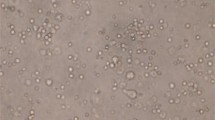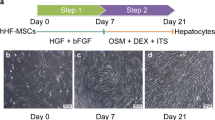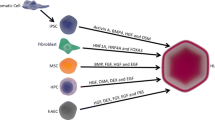Abstract
Orthotopic liver transplantation (OLT) is the only proven effective treatment for both end-stage and metabolic liver diseases. Hepatocyte transplantation is a promising alternative for OLT, but the lack of available donor livers has hampered its clinical application. Hepatocyte-like cells (HLCs) differentiated from many multi-potential stem cells can help repair damaged liver tissue. Yet almost suitable cells currently identified for human use are difficult to harvest and involve invasive procedures. Recently, a novel mesenchymal stem cell derived from human menstrual blood (MenSC) has been discovered and obtained easily and repeatedly. In this study, we examined whether the MenSCs are able to differentiate into functional HLCs in vitro. After three weeks of incubation in hepatogenic differentiation medium containing hepatocyte growth factor (HGF), fibroblast growth factor-4 (FGF-4), and oncostain M (OSM), cuboidal HLCs were observed, and cells also expressed hepatocyte-specific marker genes including albumin (ALB), α-fetoprotein (AFP), cytokeratin 18/19 (CK18/19), and cytochrome P450 1A1/3A4 (CYP1A1/3A4). Differentiated cells further demonstrated in vitro mature hepatocyte functions such as urea synthesis, glycogen storage, and indocyanine green (ICG) uptake. After intrasplenic transplantation into mice with 2/3 partial hepatectomy, the MenSC-derived HLCs were detected in recipient livers and expressed human ALB protein. We also showed that MenSC-derived HLC transplantation could restore the serum ALB level and significantly suppressed transaminase activity of liver injury animals. In conclusion, MenSCs may serve as an ideal, easily accessible source of material for tissue engineering and cell therapy of liver tissues.
Similar content being viewed by others
References
Allickson, J., Xiang, C., 2012. Human adult stem cells from menstrual blood and endometrial tissue. J. Zhejiang Univ.-Sci. B (Biomed. & Biotechnol.), 13(5):419–420. [doi:10.1631/jzus.B1200062]
Allickson, J.G., Sanchez, A., Yefimenko, N., Borlongan, C.V., Sanberg, P.R., 2011. Recent studies assessing the proliferative capability of a novel adult stem cell identified in menstrual blood. Open Stem Cell J., 3(2011):4–10. [doi:10.2174/1876893801103010004]
Banas, A., Teratani, T., Yamamoto, Y., Tokuhara, M., Takeshita, F., Quinn, G., Okochi H., Ochiya, T., 2007. Adipose tissue-derived mesenchymal stem cells as a source of human hepatocytes. Hepatology, 46(1):219–228. [doi:10.1002/hep.21704]
Bieback, K., Kern, S., Kluter, H., Eichler, H., 2004. Critical parameters for the isolation of mesenchymal stem cells from umbilical cord blood. Stem Cells, 22(4):625–634. [doi:10.1634/stemcells.22-4-625]
Borlongan, C., Kaneko, V.Y., Maki, M., Yu, S.J., Ali, M., Allickson, J.G., Sanberg, C.D., Kuzmin-Nichols, N., Sanberg, P.R., 2010. Menstrual blood cells display stem cell-like phenotypic markers and exert neuroprotection following transplantation in experimental stroke. Stem Cells Dev., 19(4):439–452. [doi:10.1089/scd.2009.0340]
Chen, Y., Dong, X.J., Zhang, G.R., Shao J.Z., Xiang, L.X., 2007. In vitro differentiation of mouse bone marrow stromal stem cells into hepatocytes induced by conditioned culture medium of hepatocytes. J. Cell Biochem., 102(1):52–63. [doi:10.1002/jcb.21275]
Chen, Y.F., Tseng, C.Y., Wang, H.W., Kuo, H.C., Yang, V.W., Lee, O.K., 2012. Rapid generation of mature hepatocyte-like cells from human induced pluripotent stem cells by an efficient three-step protocol. Hepatology, 55(4): 1193–1203. [doi:10.1002/hep.24790]
Chien, C.C., Yen, B.L., Lee, F.K., Lai, T.H., Chen, Y.C., Chan, S.H., Huang, H.I., 2006. In vitro differentiation of human placenta-derived multipotent cells into hepatocyte-like cells. Stem Cells, 24(7):1759–1768. [doi:10.1634/stem cells.2005-0521]
Cui, C.H., Uyama, T., Miyado, K., Terai, M., Kyo, S., Kiyono, T., Umezawa, A., 2007. Menstrual blood-derived cells confer human dystrophin expression in the murine model of Duchenne muscular dystrophy via cell fusion and myogenic transdifferentiation. Mol. Biol. Cell, 18(5): 1586–1594. [doi:10.1091/mbc.E06-09-0872]
de Coppi, P., Bartsch, G.Jr., Siddiqui, M.M., Xu, T., Santos, C.C., Perin, L., Mostoslavsky, G., Serre, A.C., Snyder, E.Y., Yoo, J.J., et al., 2007. Isolation of amniotic stem cell lines with potential for therapy. Nat. Biotechnol., 25(1):100–106. [doi:10.1038/nbt1274]
Dhawan, A., Mitry, R.R., Hughes, R.D., Lehec, S., Terry, C., Bansal, S., Arya, R., Wade, J.J., Verma, A., Heaton, N.D., et al., 2004. Hepatocyte transplantation for inherited factor VII deficiency. Transplantation, 78(12):1812–1814. [doi:10.1097/01.TP.0000146386.77076.47]
Fox, I.J., Chowdhury, J.R., 2004. Hepatocyte transplantation. J. Hepatol., 40(6):878–886. [doi:10.1016/j.jhep.2004.04.009]
Fox, I.J., Chowdhury, J.R., Kaufman, S.S., Goertzen, T.C., Chowdhury, N.R., Warkentin, P.I., Dorko, K., Sauter, B.V., Strom, S.C., 1998. Treatment of the Crigler-Najjar syndrome type I with hepatocyte transplantation. N. Engl. J. Med., 338(20):1422–1426. [doi:10.1056/NEJM199805 143382004]
Gunsalus, J.R., Brady, D.A., Coulter, S.M., Gray, B.M., Edge, A.S., 1997. Reduction of serum cholesterol in Watanabe rabbits by xenogeneic hepatocellular transplantation. Nat. Med., 3(1):48–53. [doi:10.1038/nm0197-48]
Hida, N., Nishiyama, N., Miyoshi, S., Kira, S., Segawa, K., Uyama, T., Mori, T., Miyado, K., Ikegami, Y., Cui, C., et al., 2008. Novel cardiac precursor-like cells from human menstrual blood-derived mesenchymal cells. Stem Cells, 26(7):1695–1704. [doi:10.1634/stemcells.2007-0826]
Huang, P., He, Z., Ji, S., Sun, H., Xiang, D., Liu, C., Hu, Y., Wang, X., Hui, L., 2011. Induction of functional hepatocyte-like cells from mouse fibroblasts by defined factors. Nature, 475(7356):386–389. [doi:10.1038/nature 10116]
Ikegami, Y., Miyoshi, S., Nishiyama, N., Hida, N., Okamoto, K., Miyado, K., Segawa, K., Ogawa, S., Umezawa, A., 2010. Serum-independent cardiomyogenic transdifferentiation in human endometrium-derived mesenchymal cells. Artif. Organs, 34(4):280–288. [doi:10.1111/j.1525-1594.2009.00859.x]
Lee, K.D., Kuo, T.K., Whang-Peng, J., Chung, Y.F., Lin, C.T., Chou, S.H., Chen, J.R., Chen, Y.P., Lee, O.K., 2004. In vitro hepatic differentiation of human mesenchymal stem cells. Hepatology, 40(6):1275–1284. [doi:10.1002/hep. 20469]
Li, H.Y., Chen, Y.J., Chen, S.J., Kao, C.L., Tseng, L.M., Lo, W.L., Chang, C.M., Yang, D.M., Ku, H.H., Twu, N.F., et al., 2010. Induction of insulin-producing cells derived from endometrial mesenchymal stem-like cells. J. Pharmacol. Exp. Ther., 335(3):817–829. [doi:10.1124/jpet.110.169284]
Li, J., Tao, R., Wu, W., Cao, H., Xin, J., Guo, J., Jiang, L., Hong, X., Demetriou, A.A., Farkas, D., et al., 2010. Transcriptional profiling and hepatogenic potential of acute hepatic failure-derived bone marrow mesenchymal stem cells. Differentiation, 80(2–3):166–174. [doi:10.1016/j.diff.2010.04.002]
Lin, J., Xiang, D., Zhang, J.L., Allickson, J., Xiang, C., 2011. Plasticity of human menstrual blood stem cells derived from the endometrium. J. Zhejiang Univ.-Sci. B (Biomed. & Biotechnol.), 12(5):372–380. [doi:10.1631/jzus. B1100015]
Meng, X., Ichim, T.E., Zhong, J., Rogers, A., Yin, Z., Jackson, J., Wang, H., Ge, W., Bogin, V., Chan, K.W., et al., 2007. Endometrial regenerative cells: a novel stem cell population. J. Transl. Med., 5:57. [doi:10.1186/1479-5876-5-57]
Mitchell, C., Willenbring, H., 2008. A reproducible and well-tolerated method for 2/3 partial hepatectomy in mice. Nat. Protoc., 3(7):1167–1170. [doi:10.1038/nprot.2008.80]
Muraca, M., Gerunda, G., Neri, D., Vilei, M.T., Granato, A., Feltracco, P., Meroni, M., Giron, G., Burlina, A.B., 2002. Hepatocyte transplantation as a treatment for glycogen storage disease type 1a. Lancet, 359(9303):317–318. [doi:10.1016/S0140-6736(02)07529-3]
Murphy, M.P., Wang, H., Patel, A.N., Kambhampati, S., Angle, N., Chan, K., Marleau, A.M., Pyszniak, A., Carrier, E., Ichim, T.E., et al., 2008. Allogeneic endometrial regenerative cells: an “off the shelf solution” for critical limb ischemia? J. Transl. Med., 6(1):45. [doi:10.1186/1479-5876-6-45]
Overturf, K., Al-Dhalimy, M., Tanguay, R., Brantly, M., Ou, C.N., Finegold, M., Grompe, M., 1996. Hepatocytes corrected by gene therapy are selected in vivo in a murine model of hereditary tyrosinaemia type I. Nat. Genet., 12(3):266–273. [doi:10.1038/ng0396-266]
Park, S.M., Vo, K., Lallier, M., Cloutier, A.S., Brochu, P., Alvarez, F., Martin, S.R., 2006. Hepatocyte transplantation in the Long Evans Cinnamon rat model of Wilson’s disease. Cell Transplant., 15(1):13–22. [doi:10.3727/000000006783982188]
Patel, A.N., Silva, F., 2008. Menstrual blood stromal cells: the potential for regenerative medicine. Regen. Med., 3(4): 443–444. [doi:10.2217/17460751.3.4.443]
Patel, A.N., Park, E., Kuzman, M., Benetti, F., Silva, F.J., Allickson, J.G., 2008. Multipotent menstrual blood stromal stem cells: isolation, characterization, and differentiation. Cell Transplant., 17(3):303–311. [doi:10.3727/096368908784153922]
Peleman, R.R., Gavaler, J.S., van Thiel, D.H., Esquivel, C., Gordon, R., Iwatsuki, S., Starzl, T.E., 1987. Orthotopic liver transplantation for acute and subacute hepatic failure in adults. Hepatology, 7(3):484–489. [doi:10.1002/hep. 1840070312]
Phuc, P.V., Lam, D.H., Ngoc, V.B., Thu, D.T., Nguyet, N.T., Ngoc, P.K., 2011. Production of functional dendritic cells from menstrual blood—a new dendritic cell source for immune therapy. In Vitro Cell Dev. Biol. Anim., 47(5–6): 368–375. [doi:10.1007/s11626-011-9399-2]
Pittenger, M.F., Mackay, A.M., Beck, S.C., Jaiswal, R.K., Douglas, R., Mosca, J.D., Moorman, M.A., Simonetti, D.W., Craig, S., Marshak, D.R., 1999. Multilineage potential of adult human mesenchymal stem cells. Science, 284(5411):143–147. [doi:10.1126/science.284.5411.143]
Sanberg, P.R., Eve, D.J., Willing, A.E., Garbuzova-Davis, S., Tan, J., Sanberg, C.D., Allickson, J.G., Cruz, L.E., Borlongan, C.V., 2011. The treatment of neurodegenerative disorders using umbilical cord blood and menstrual blood-derived stem cells. Cell Transplant., 20(1):85–94. [doi:10.3727/096368910X532855]
Santamaria, X., Massasa, E.E., Feng, Y., Wolff, E., Taylor, H.S., 2011. Derivation of insulin producing cells from human endometrial stromal stem cells and use in the treatment of murine diabetes. Mol. Ther., 19(11): 2065–2071. [doi:10.1038/mt.2011.173]
Schwab, K.E., Gargett, C.E., 2007. Co-expression of two perivascular cell markers isolates mesenchymal stem-like cells from human endometrium. Hum. Reprod., 22(11): 2903–2911. [doi:10.1093/humrep/dem265]
Schwartz, R.E., Reyes, M., Koodie, L., Jiang, Y., Blackstad, M., Lund, T., Lenvik, T., Johnson, S., Hu, W.S., Verfaillie, C.M., 2002. Multipotent adult progenitor cells from bone marrow differentiate into functional hepatocyte-like cells. J. Clin. Invest., 109(10):1291–1302. [doi:10.1172/JCI15182]
Seo, M.J., Suh, S.Y., Bae, Y.C., Jung, J.S., 2005. Differentiation of human adipose stromal cells into hepatic lineage in vitro and in vivo. Biochem. Biophys. Res. Commun., 328(1):258–264. [doi:10.1016/j.bbrc.2004.12.158]
Snykers, S., Vanhaecke, T., Papeleu, P., Luttun, A., Jiang, Y., van der Heyden, Y., Verfaillie, C., Rogiers, V., 2006. Sequential exposure to cytokines reflecting embryogenesis: the key for in vitro differentiation of adult bone marrow stem cells into functional hepatocyte-like cells. Toxicol. Sci., 94(2):330–341. [doi:10.1093/toxsci/kfl058]
Stephenne, X., Najimi, M., Sibille, C., Nassogne, M.C., Smets, F., Sokal, E.M., 2006. Sustained engraftment and tissue enzyme activity after liver cell transplantation for argininosuccinate lyase deficiency. Gastroenterology, 130(4): 1317–1323. [doi:10.1053/j.gastro.2006.01.008]
Toyoda, M., Cui, C., Umezawa, A., 2007. Myogenic transdifferentiation of menstrual blood-derived cells. Acta Myol., 26(3):176–178.
Yamamoto, H., Quinn, G., Asari, A., Yamanokuchi, H., Teratani, T., Terada, M., Ochiya, T., 2003. Differentiation of embryonic stem cells into hepatocytes: biological functions and therapeutic application. Hepatology, 37(5): 983–993. [doi:10.1053/jhep.2003.50202]
Yu, J., Yang, J., Pan, Q., Ma, J., Li, J., Li, Y., Cao, H., Wang, Y., Li, L., 2012. In vivo hepatic differentiation of mesenchymal stem cells from human umbilical cord blood after transplantation into mice with liver injury. Biochem. Biophys. Res. Commun., 422(4):539–545. [doi:10.1016/j.bbrc.2012.04.156]
Author information
Authors and Affiliations
Corresponding authors
Additional information
The two authors contributed equally to this work
Project supported by the National High-Tech R&D Program (863) of China (Nos. 2011AA020102 and 2012AA020905), the Key Technologies R&D Program of Zhejiang Province (Nos. 2012C13015-2 and 2011C13029-1), the Hangzhou Key Technologies R&D Program (No. 20122513A49), and the National Natural Science Foundation of China (Nos. 81201783 and 81201089)
Rights and permissions
About this article
Cite this article
Mou, Xz., Lin, J., Chen, Jy. et al. Menstrual blood-derived mesenchymal stem cells differentiate into functional hepatocyte-like cells. J. Zhejiang Univ. Sci. B 14, 961–972 (2013). https://doi.org/10.1631/jzus.B1300081
Received:
Accepted:
Published:
Issue Date:
DOI: https://doi.org/10.1631/jzus.B1300081
Key words
- Menstrual blood-derived mesenchymal stem cell (MenSC)
- Differentiation
- Hepatocyte
- Intrasplenic transplantation
- Partial hepatectomy




